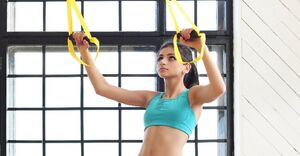
The Athlete’s Choice: Deciding Between Standard and Competition Kettlebells
Are you looking to take your fitness routine to the next level with kettlebells, but not sure where to start?
In this comprehensive article, we will explore the differences between standard and competition kettlebells.
From the various sizes available to the benefits they offer, we will cover everything you need to know to make an informed decision.
Whether you are an athlete looking to enhance your performance or simply looking to add variety to your workouts, we will help you choose the right kettlebell for your needs.
What Are Kettlebells?
Kettlebells are versatile gym equipment used by athletes in various fitness training programs and exercise routines. These weights, resembling a cannonball with a handle, offer a dynamic workout experience.
Originating in Russia in the 1700s, kettlebells were initially used as counterweights in market scales. Over time, they evolved into fitness tools due to their effectiveness in strength and conditioning. Athletes from all disciplines, including weightlifters, martial artists, and CrossFit enthusiasts, have integrated kettlebells into their training regimens.
These compact devices allow for a wide range of movements such as swings, snatches, and Turkish get-ups, engaging multiple muscle groups simultaneously. Their versatility makes them a popular choice for enhancing power, agility, and endurance in athletes of all levels.
What Are Standard Kettlebells?
Standard kettlebells are commonly used by athletes to build strength and endurance due to their consistent weight and quality material construction. These kettlebells are designed to meet general fitness needs.
Their sturdy construction, often made from cast iron or steel, ensures durability even in rigorous workout routines. The standard shape and size of kettlebells allow for proper grip and comfortable handling during various exercises. Athletes appreciate the versatility of these kettlebells, using them for ballistic exercises like swings and snatches as well as traditional strength training movements such as squats and presses. The balanced weight distribution of standard kettlebells helps develop overall strength and power, making them an essential tool in any athlete’s training program.
What Are the Different Sizes of Standard Kettlebells?
Standard kettlebells come in various sizes and weights to accommodate different fitness levels and exercise routines. Athletes can choose from a range of options to suit their training needs.
For beginners or those focusing on toning and endurance, lighter kettlebells around 5-15 pounds are ideal. Intermediate users may benefit from kettlebells weighing 15-30 pounds, offering a balance of challenge and manageability. Advanced athletes or those aiming for strength and power might opt for heavier kettlebells ranging from 30-50 pounds. It’s crucial to select the appropriate weight to prevent injury and maximize results. Understanding how different sizes impact exercises can help individuals progress effectively in their fitness journey.
What Are the Benefits of Standard Kettlebells?
Standard kettlebells offer numerous benefits to athletes, including improved strength, endurance, and targeted muscle group engagement. These benefits contribute to overall athletic performance.
By incorporating standard kettlebells into their training regimen, athletes can enhance their functional strength, enabling them to generate power more efficiently. The dynamic movements required when using kettlebells also help in developing cardiovascular endurance, crucial for sustaining performance during prolonged bouts of physical activity. The varied exercises that can be performed with kettlebells activate multiple muscle groups simultaneously, promoting better coordination and stability, which are essential in preventing injuries and improving agility on the field.
What Are Competition Kettlebells?
Competition kettlebells are precision-engineered equipment designed for athletes participating in kettlebell sport competitions. These kettlebells are crafted to meet specific standards for optimal performance.
Their specialized design focuses on ergonomics and weight distribution to ensure efficient movements like swings and snatches, which are fundamental in kettlebell sport. The shape of competition kettlebells, with a consistent handle diameter and smooth finish, allows athletes to perform fluid transitions and maintain proper technique during competitions. These features not only enhance performance but also help reduce the risk of injuries, making them ideal for high-level athletes looking to excel in kettlebell sport events.
What Are the Different Sizes of Competition Kettlebells?
Competition kettlebells are available in different sizes and weights tailored to meet the standards of kettlebell sport competitions. Athletes can choose from a variety of options based on their competition requirements.
The range of competition kettlebell sizes typically starts from 8kg for beginners and goes up to 32kg or more for advanced athletes, all designed in accordance with official competition standards. Smaller sizes like 8kg or 12kg are often preferred by novices or athletes in lower weight categories, allowing them to focus on technique and form.
Medium-sized kettlebells around 16kg to 24kg are suitable for intermediate level participants, providing a balance between weight and challenge. The heavier weights such as 28kg and 32kg are commonly used by experienced lifters competing in higher weight divisions, offering the necessary intensity and resistance for their level of competition.
What Are the Benefits of Competition Kettlebells?
Competition kettlebells offer athletes advantages such as enhanced performance, improved endurance, and refined technique precision necessary for competitive kettlebell events. These benefits elevate an athlete’s competitive edge.
By incorporating competition kettlebells into their training regimen, athletes can experience a significant improvement in their overall strength and power. The design of competition kettlebells allows for smoother and more fluid movements, enabling athletes to enhance their coordination and control. This, in turn, leads to improved muscle engagement and stability, ultimately contributing to better athletic performance. The consistent use of competition kettlebells can help athletes develop a higher level of cardiovascular endurance, enabling them to sustain intense physical exertion for longer durations during competitions.
What Are the Differences Between Standard and Competition Kettlebells?
Standard and competition kettlebells vary in weight distribution, handle diameter, and material quality, distinguishing their suitability for general fitness training versus specialized competition use. Athletes need to understand these differences for optimal performance.
Competition kettlebells are designed for standardized weights across all sizes, enabling consistent training experiences for athletes in competitions. Their handles are typically thinner and uniform in diameter, promoting a secure grip during high-intensity movements. In contrast, standard kettlebells have varying handle sizes that may challenge grip strength differently with each weight level. Material composition also sets them apart, with competition kettlebells often crafted from steel for durability and specific weight accuracy, while standard kettlebells may feature a broader range of materials.
Weight Distribution
Weight distribution differs between standard and competition kettlebells, affecting the balance and feel of the equipment during exercises. Athletes should consider this factor when choosing the appropriate kettlebell type for their routines.
-
Standard kettlebells typically have a more even weight distribution, making them well-suited for traditional strength training and general fitness workouts.
-
On the other hand, competition kettlebells have a specific weight distribution that requires greater control and technique to handle effectively, making them ideal for more advanced users or competitive athletes.
The balance provided by the weight distribution in each type of kettlebell plays a significant role in how athletes engage their muscles and maintain proper form throughout their workout, ultimately influencing the overall effectiveness of their training sessions.
Handle Diameter
The handle diameter of standard and competition kettlebells varies, impacting grip comfort and technique execution for athletes. Understanding handle differences is crucial for choosing the right kettlebell type.
A larger handle diameter on a kettlebell provides more surface area for the hand to grip onto, which can be advantageous for individuals with larger hands or those seeking a more stable grip. For athletes with smaller hands, a smaller handle diameter may be preferred as it allows for a tighter grip and better control during movements. The ergonomic design of the handle size can greatly influence an athlete’s performance by affecting hand positioning, wrist alignment, and overall comfort during kettlebell exercises.
Handle Shape
The handle shape of standard and competition kettlebells varies in design, impacting comfort and control during exercises. Athletes should select a handle shape that aligns with their training preferences and performance goals.
- Standard kettlebells typically feature a traditional curved handle, which is suitable for most users and allows for a secure grip.
- On the other hand, competition kettlebells are designed with a handle that is more rectangular and uniform in size, promoting a consistent grip for competition lifters.
The ergonomic differences in handle shapes play a crucial role in preventing hand fatigue and enhancing overall training satisfaction. For athletes aiming for improved performance and stability in their kettlebell exercises, the choice of handle shape should not be overlooked.
Price
Price considerations differ between standard and competition kettlebells, with variations in cost based on quality, brand, and features. Athletes should weigh these factors when making a purchasing decision.
When looking at standard kettlebells, the prices tend to be more budget-friendly, making them a suitable option for beginners or those looking for a cost-effective solution.
On the other hand, competition kettlebells often come with a higher price tag due to their specific design and strict adherence to weight standards.
Factors such as the reputation of the brand manufacturing the kettlebells, the material used in their construction, and any additional features like textured handles or weight markers can also influence the overall price point of the kettlebell.
These pricing differences play a significant role in an athlete’s equipment selection process, as they must balance quality and cost to find the best fit for their training needs.
Which Type of Kettlebell is Best for Athletes?
Athletes should consider their fitness level, skill proficiency, and training program preferences when selecting between standard and competition kettlebells. Personal choice plays a crucial role in determining the ideal kettlebell type for individual needs.
When deciding on a kettlebell type, it’s essential to assess your current strength and endurance levels to ensure that the weight is suitable for your workouts. For those aiming to enhance their technique and form, choosing a kettlebell that aligns with their skill level is fundamental. Understanding the specific demands of your training routine can guide you towards the right kettlebell design. Factors such as grip size, handle width, and overall feel can significantly impact your performance and comfort during kettlebell exercises.
Considerations for Different Exercises
Athletes should consider their fitness level and exercise technique requirements when selecting a kettlebell type for different workouts. Understanding how each kettlebell variant targets specific muscle groups is essential for tailored training.
Variations in kettlebell designs, such as standard and competition styles, can significantly impact the intensity and focus of a workout. Standard kettlebells are often preferred for general fitness routines, providing versatility for various exercises. On the other hand, competition kettlebells, with their consistent size and handle dimensions, are favored for specific technique-driven movements like snatches and cleans. By choosing the appropriate kettlebell type, athletes can maximize muscle activation, improve form, and enhance overall workout efficiency.
Personal Preference and Comfort
Athletes should prioritize personal preference and comfort factors such as grip feel, handle design, and overall weight sensation when deciding between standard and competition kettlebells. Training satisfaction and performance improvement rely on individual comfort levels.
The way a kettlebell feels in an athlete’s hand can greatly influence their workout experience. Opting for a kettlebell with a grip that feels natural and secure can enhance grip strength and reduce the risk of injury during high-intensity movements.
The design of the handle plays a significant role in how comfortable and effective the kettlebell is to use. Athletes should aim for a handle that allows for a firm grip without causing strain or discomfort. The overall weight of the kettlebell is crucial for maintaining proper form and executing movements with ease.
How to Choose the Right Kettlebell for Your Needs?
Selecting the appropriate kettlebell requires athletes to make informed decisions based on their expertise level, training goals, and equipment preferences. Gathering recommendations and reviews can aid in the decision-making process.
When choosing a kettlebell, it’s crucial to consider your current fitness level and specific workout objectives. Expertise plays a vital role in determining the right weight and type of kettlebell for your routines. Whether you’re a beginner or seasoned athlete, seeking guidance from professionals in the field can provide valuable insights.
Browsing through equipment reviews and testimonials from fellow athletes can offer practical perspectives and help you make a well-informed choice. Don’t hesitate to tap into the expertise of trainers and the collective knowledge of the fitness community to ensure that you find the perfect kettlebell to enhance your training regimen.
Assessing Your Fitness Level
Assessing your current fitness level, including endurance, strength, and conditioning benchmarks, is crucial in determining the appropriate kettlebell weight and type for your training regimen. Understanding your physical capabilities is essential for progress.
By accurately assessing your endurance, strength, and conditioning levels, you can tailor your kettlebell workouts to match your body’s current abilities. This self-assessment allows you to select the right weight and intensity for effective training outcomes. Knowing your limits helps prevent injury and ensures gradual improvement in both strength and overall fitness.
Be honest with yourself about where you stand physically to create a training plan that challenges you appropriately yet safely. Embrace this self-awareness as a foundation for achieving your fitness goals with kettlebell exercises.
Consulting with a Trainer
Consulting with a certified trainer or fitness expert can provide athletes with valuable insights into kettlebell selection, proper technique, and form considerations. Trainers offer personalized recommendations based on individual needs.
This personalized approach ensures that athletes receive guidance specifically geared towards their goals and skill levels, making their training sessions more effective and efficient. Working closely with a trainer allows athletes to fine-tune their movements, correct any form errors, and prevent potential injuries. By incorporating expert advice into their training routines, athletes can optimize their performance and progress steadily towards achieving their desired fitness outcomes.
Trying Out Different Kettlebells
Experimenting with various kettlebell types and weights as part of your training routine can help athletes identify the most suitable option based on experience and personal preference. Trying different kettlebells enhances workout diversity and performance evaluation.
Engaging in trial sessions with different kettlebell variations allows athletes to gain valuable hands-on experience in selecting the most effective tool for their individual needs. By testing out different sizes and handle types, athletes can pinpoint which kettlebell feels most comfortable and provides optimal results during their workouts.




No Comments